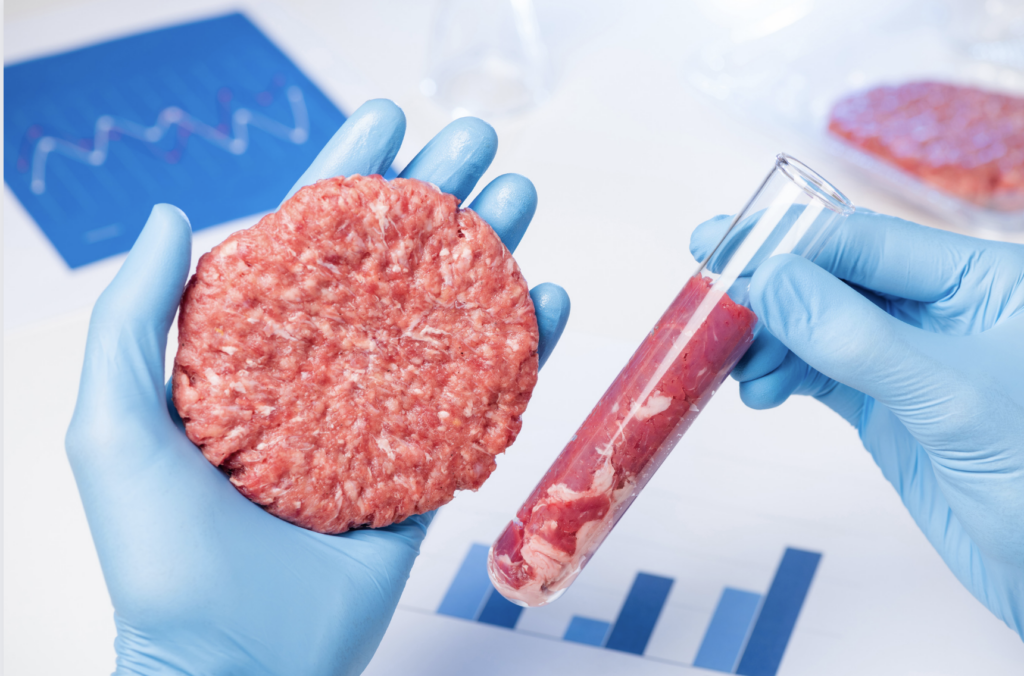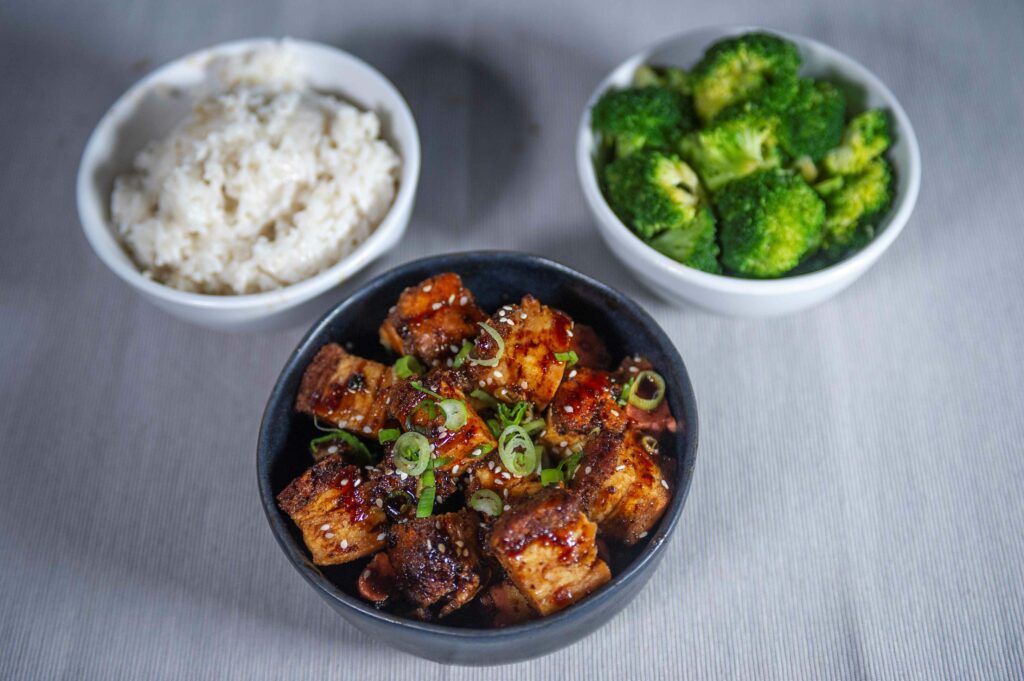Cultivated meat has the potential of becoming a game changer in providing meat to the growing global population without exceeding planetary boundaries, according to a new book by two leading animal welfare advocates.
The official launch of the book - Cultivated Meat to Secure Our Future: Hope for Animals, Food Security, and the Environment - took place in Brussels last week (7 February). Co-edited by Michel Vandenbosch and Philip Lymbery, the book includes chapters by experts in different fields, from health and animal welfare to environmental, ethical and religious aspects of cultivated meat.
Vandenbosch is founder and President of GAIA, Belgium’s most influential animal welfare and rights organisation. Lymbery is Global Chief Executive of Compassion in World Farming International. Both of them are also funding board members of the World Federation for Animals (WFA).
As previously reported, the perhaps first-ever symposium on cultivated meat in Brussels took place in April 2022. In an op-ed, Reineke Hameleers, CEO of Eurogroup for Animals, visualized the future without the need to rear billions of animals, transport them over long distances, and slaughter them. No more forests would be cleared to make room for monocultures or grassland to feed livestock.
Another benefit would be a massive reduction in methane, ammonia, and particulate matter emissions from livestock farms. When cultivated meat is produced with renewable energy, the environmental impact is significantly reduced compared to conventional meat of all kinds. Methane in cattle farming was left out of the Industrial Emissions Directive and will be a challenge for the Global Methane Pledge.
Time for resetting food system

Co-editors Philip Lymbery (to the left) and Michel Vandenbosch at the book launch in Brussels on 7 February, credit: The Brussels Times
Cultivated meat or “cell-cultured meat” originates from a few cells obtained from living animals. These cells can grow under controlled conditions in bioreactors. In their book, Lymbery and Vandenbosch argue that cultivated meat holds the promise of becoming a green and ethical alternative to the slaughtering of animals.
They told The Brussels Times that they co-edited the book for several reasons: to protect the future against climate change, to protest against factory farming of animals, and to draw the attention to the need of a transformation of the food system where cultivated meat becomes an important part of the solution.
“Time is running out to reset the food system,” Lymbery warned. “Cultivated meet offers a real solution but the EU is falling behind and we need to speed up the transformation of the food system.”
Vandenbosch underlined that solutions to cultivated meat from chickens, pigs and cows have already been developed by companies in the US, Israel and The Netherlands. Some of them have applied for regulatory authorization and their products have recently been approved by the food safety authorities in Singapore, the US and Israel. But the EU is lagging behind, he says.
“There are still prejudices in the EU against cultivated meat,” he said, referring to a recent note which was discussed by the EU agriculture ministers at the AGRIFISH council meeting last January. The note, tabled by Austria, France, and Italy, was supported by the Czech, Cypriot, Greek, Hungarian, Luxembourg, Maltese, Polish, Romanian, Slovak and Spanish delegations.
These countries claim that new “lab-grown artificial cell-based food production practices … represent a threat to primary farm-based approaches and genuine food production methods that are at the very heart of the European farming model.” Italy has already legislated on a ban on the production and marketing of cultivated meat to “protect interests relating to health and cultural heritage”.
Other countries, for example Denmark and The Netherlands, voiced their disagreement with the note. The Netherlands is in the forefront in developing cultivated meat in the EU. Dutch companies can now hand in their dossiers to request approvals to hold tastings under controlled conditions before authorization of their products.
While understanding the concerns by other countries, they stressed the need for global food security and were positive towards the development of innovative biotechnological solutions that could lead to new sustainable proteins.
The note lists a number of questions showing the bias against cultivated meat. “Can cell-based meat production be considered as a more animal friendly alternative to animal husbandry, if it does involve the killing of animals?”, was one of the questions.
“Given that we live in a world in which animals are produced for meat, not a single additional animal has to die to provide the raw material cultivated meat manufacturers need,” philosopher Julian Baggini writes in the book.
Cultivated meat is non-slaughtered meat and could therefore also become an acceptable alternative for Jews and Muslims whose ritual slaughter without stunning has been forbidden in Belgium. (While slaughter with ineffective and painful stunning methods continues to violate EU rules). If harm reduction is the guide, cultivated meat might even become an alternative for Hindus.
Animal friendly meat lovers target group
Vandenbosch is careful in defining the target group for cultivated meat. It is not vegetarians and vegans who have chosen a plant-based diet. (Their number in Belgium is estimated to ca 8 % of the population and is expected to double.) The target group is those who still want to eat meat and feel the taste of meat but not at the expense of climate change and animal welfare.
With cultivated meat, they do not have to change their eating habits, he says. The production of cultivated meat does not harm the animals as there is no need to slaughter them for food. He described the extraction of cells from living animals as “harmless biopsy”.
A crucial aspect for shifting food consumption patterns towards more sustainable eating is to tackle the barriers that consumers encounter. Cultivated meat should be labelled as meat, Lymbery says. “It’s a renewable and sustainable alternative to other meats.” He is convinced that cultivated meat will take a growing share of the global meat market, which today is worth 1.4 trillion US dollars.
The first approval and commercial sale of cultivated meat (chicken nuggets) took place in Singapore in 2019. It was followed by approvals of cultivated meat developed by UPSIDE Foods and East Just for the American market by the authorities in the US (FDA in 2022 and USDA in 2023). In 2023, Dutch company Meatable was granted approval by the Singapore Food Agency for its cultivated pork meat products.
The latest regulatory approval was granted in January by the Israeli health ministry to the start-up Aleph Farms for its cultivated beef steaks. It was among the first approvals for non-chicken cultivated meat anywhere in the world and also the first one ever for cultivated meat of any kind in the Middle East.
According to the book, the latest projections suggest that cultivated meat could secure 10 % of the meat market by 2030 and up to 35 % by 2040. “I believe the obstacles will be overcome,” Lymbery says “We have no choice, we have only a few years to create a decent future for our children, for coming generations.”
Vandenbosch agreed. “It’s not a question about if but when,” he says. “It’s not easy and we need to convince the decision-makers on national and EU levels.”
Currently cultivated meat is being developed by small startups. Baggini, the philosopher, warns against putting power in the food system in the hands of a small number of technological pioneers with patents.
After commercialization and scaling-up, the market might be dominated by big companies. In their vision for the future, Lymbery and Vandenbosch envisage many small farmers starting new businesses with a number of bioreactors to grow cultivated meat and using their lands for useful crops instead of feeds to factory-farmed animals.
Regulatory process in the EU

Credit: Canvas
Are there regulatory barriers for approving cultivated meat in the EU? There is a regulatory framework in place in the form of the Novel Foods Regulation. Without authorization by the European Food Safety Agency (EFSA), no cultivated meat products can be placed on the EU market. Nutritional, food safety and animal welfare aspects are the areas that EFSA works on.
But food developers are not queuing at EFSA. “Out of the around 240 novel food applications we have received for safety assessment since the implementation of the new regulation in 2018, we have not yet received any applications for risk assessment concerning cell culture-derived food applications of animal origin,” a spokesperson of EFSA told The Brussels Times.
“Since cell culture-derived food and food ingredients have been defined as novel foods, their approval follows the novel food legislative process,” the spokesperson explained. “This means that an applicant must send an application, containing all the necessary information, studies and data, to the European Commission for an initial check of its completeness.”
It is not clear if EFSA in the meantime can initiate or be requested by the Commission to carry out an impact assessment or scientific study prior to a specific authorization application. “Each product requires a thorough safety assessment. As for an impact assessment that covers socio-economic, ethical and other issues, this is a question for the Commission.”
Mosa Meat, a Dutch startup which unveiled the first cultivated beef burger already in 2013, applied last year for authorization in Singapore.
Is it more cumbersome to apply for approval in the EU? “The EU is certainly where we want to submit an authorization request and we are actively preparing to submit the first European dossier,” a spokesperson of Mosa Meat replied.
“The European food safety standards are highly regarded globally and we look forward to working with EFSA to demonstrate the safety of our cultivated beef, as has been done for other cultivated food products so far in Singapore, the United States, Israel and Australia. The scientific risk assessment conducted by EFSA to establish the safety of a Novel Food will be slightly different for each product.”
From cell sample to thousands of tonnes of meat
Aleph Farms, the Israeli company, told The Brussels Times that its recent approval only grants it permission to produce and market Aleph Cuts in Israel. “Entrance to Asia (via Singapore) and the Middle East is currently our main focus.” The company has also submitted applications to Switzerland, the UK and the US and is advancing applications for other countries. It also plans to apply for approval at EFSA.
“We believe that for cultivated meat to enter the European market, there's a need to develop frameworks for collaboration with livestock farmers,” the spokesperson explained.
“Cellular agriculture is meant to coexist and complement sustainable livestock farming, and be one of the solutions that can diversify the production of animal products for enhanced sustainability, food security, animal welfare and public health.” Aleph Farms does not insist that cultivated meat should necessarily be labelled as meat.
The first Aleph Cut to be introduced to diners in Israel — the cultivated Petit Steak — is made of non-modified, non-immortalized cells of a premium Black Angus cow, as well as a plant protein matrix made of soy and wheat.
No antibiotics are used in production, nor are any present in the final product. Aside from starter cells that come from one of the cow’s fertilized eggs, there are zero animal-derived components in the cultivation process and the final product.
He is referring to fetal bovine serum (FBS), a major animal welfare concern because it is extracted from unborn calves. While this has been used during the research and development stage to grow the cells, companies are developing animal free mediums and moving away from FBS.
Aleph Farms decided from the start that it would develop its products without the use of FBS. “FBS is expensive and it made no sense to use them. Over the last few years, we’ve developed production processes for essential growth medium proteins that serve as a replacement for proteins found in FBS.”
“All we need is a one-time collection of cells from a living animal. After allowing it to develop for a short period of time, we derive cells from it. These cells have the potential to mature into the different types of cells that make up meat, like muscle and collagen-producing cells. The cells are preserved at sub-zero temperatures in our cell bank.”
“When at scale, we expect to grow thousands of tonnes of steak from this single collection.”
How many bioreactors are needed for production on a large scale? “Some existing models of cultivators, originating from the biomedical space, are indeed not optimized for cultivated meat production in terms of cost and availability. This is why we have agreements with suppliers to design customized cultivators that can support a cost-efficient scale-up of our production.”
Next meeting of the Agriculture and Fisheries Council will take place on 26 February under the shadow of protesting farmers and deal with "rapid and structural responses to the crisis situation facing the agricultural sector". The EU is not going to wait for the outcome of the strategic dialogue on the future of agriculture which the Commission launched recently.
M. Apelblat
The Brussels Times

